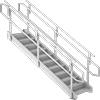Filter by
Material
Rail Material
Overall Height
Platform Height
Ladder Type
Finish
Ladder Height
Weight Capacity
Specifications Met
Platform Tread
Export Control Classification Number (ECCN)
DFARS Specialty Metals
Step Material
Material Handling
Building and Machinery Hardware
Safety Equipment
Electrical

















































